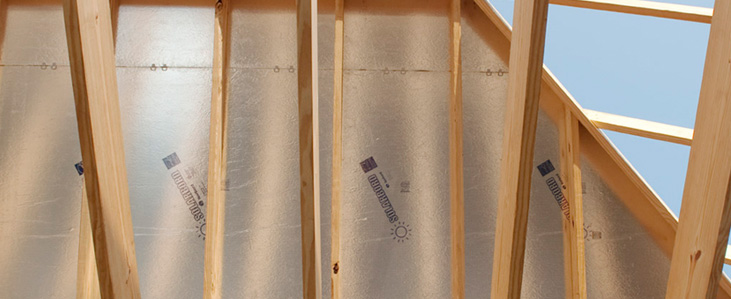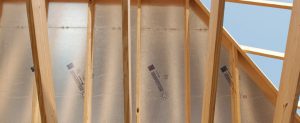
When installing attic insulation, a case can be made for both radiant barrier sheathing with typical types of insulation as well as spray foam insulation. A number of factors should be taken into consideration when choosing between these two, especially the climate zone that you’re building in. Radiant barrier sheathing is inexpensive and reflects thermal radiation to keep attic spaces cool. Spray foam offers insulation and provides some sound proofing from outside noise.
Radiant Barrier Sheathing
Attic spaces are predominantly heated through radiation. The foil surfaces of radiant barriers reflect the heat and prevent it from radiating into the attic space. That means the home will be more comfortable and the efficiency of attic insulation and the AC system will be improved.
 OSB radiant barrier sheathing can reflect up to 97% of radiation and can significantly reduce attic temperatures. Dave Lewis from West Fraser: “The use of radiant barrier sheathing can reduce the attic temperature by about 30°F. Estimates put a payback for the radiant barrier of 1 to 2 years in energy savings from then on it acts as a passive energy saving system that never wears out.”
OSB radiant barrier sheathing can reflect up to 97% of radiation and can significantly reduce attic temperatures. Dave Lewis from West Fraser: “The use of radiant barrier sheathing can reduce the attic temperature by about 30°F. Estimates put a payback for the radiant barrier of 1 to 2 years in energy savings from then on it acts as a passive energy saving system that never wears out.”
This means that your attic stays cooler in hot summer months and radiates less heat into your home which translates into savings on your summer cooling costs of up to 17%. Cooler attics and more comfortable living spaces improve your cooling system efficiency and prolongs its life by reducing cycle times. Radiant barrier sheathing may only cost an additional few hundred dollars per house over regular sheathing and it requires no special tools or trades to install. Radiant barriers increase shingle temperature by only a few degrees and do not affect shingle warranties.
Elizabeth D Kaufman, Architect: “I have long been skeptical of radiant barrier products. I was completely surprised when I found that the shell building I inspected yesterday was 80- 90 degrees inside. It was 106 outside!!!! The only possible explanation was the West Fraser Solarbord decking. The building had no ceilings, no wall insulation, and no gypsum board. The windows and door were not caulked. The windows were low quality, dual pane, not Low-E and faced south and west. I really expected it to be beyond sweltering when I arrived at 1:30pm. I had to insist that the door be kept closed to keep the ‘cool’ air inside.”
Radiant barrier sheathing should only be used in cooling climate zones 1, 2, & 3. Radiant barrier sheathing can only be retrofitted to existing homes when the roof is being replaced. It is installed with the foil facing the attic and must have air space (minimum of ¾”) in front of the foil to work and of course code required ventilation.
Spray foam insulation
Spray foam is a great way to keep heat in your home in the winter and increased R-values will also make your attic space cooler in the hotter months. In small homes where space is at a premium or in areas that are difficult to insulate, spray foam may be a good option.
Spray foam insulation does provide greater R-value per inch as well as a way to seal your home. Spray foam insulation also helps to reduce the temperature difference between the home and the attic space. If you are placing ductwork in this space, this will help your heating and cooling systems to function more efficiently. However, since you are conditioning an additional floor, you will have to weigh energy savings with the cost of heating and cooling that extra space.
Spray foam is expensive and may cost you thousands of dollars over conventional types of insulation. It also requires trained and skilled installers because, like any insulation, there can be gaps and holes if installation is not done properly. In most cases it is the installer that tells you the R-value in your home and not an independent agency.
Spray foam installed to the underside of your roof leaves no way to cool that side of the roof system. This may cause your shingles to overheat which may reduce their longevity and require you to replace them sooner. Check your shingle manufacturer’s warranties as some void or limit warranties or require special roof details when foam is used on the underside of the sheathing.
Spray foam insulation doesn’t protect attic spaces from radiant heat, but does protect them from convection and conduction. In the summer, radiant heat is the biggest contributor to heated attic spaces, so spray foam insulation may not be as effective in keeping attics cool.
Combining these two insulating methods in order to optimize your insulation won’t work. Placing materials up against the foil negates the benefit of the radiant barrier and heat will simply be conducted through the materials and into the attic space. When it comes to hot attic spaces, radiant heat is the main culprit and radiant heat barriers are an effective and economical option. Both radiant barriers and spray foam offer benefits so all options including a cost/value analysis should be considered. Also consider a third option; raised heel trusses as they create space for more insulation. Using more blown cellulose or fiberglass batts can exponentially improve your R-value and give you more bang for your insulation buck.
